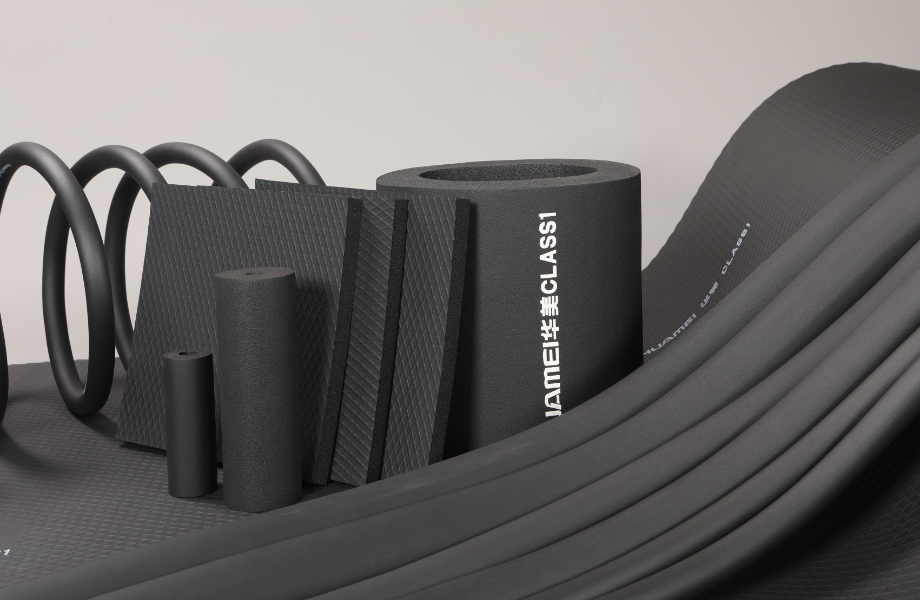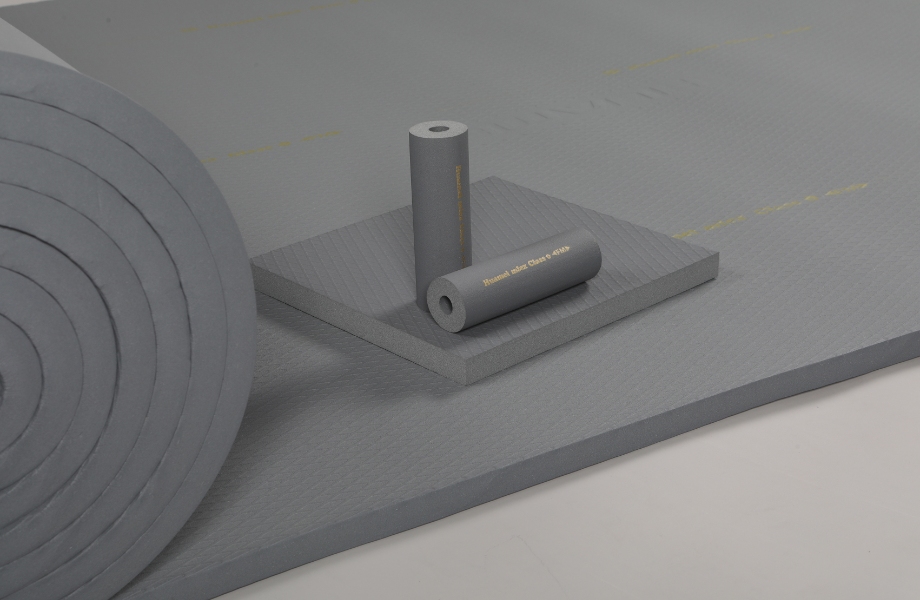E-mail: marketing@hbhuamei.com
Living comfortably indoors, regardless of the weather outside, used to be a luxury only the wealthy could afford. But thanks to modern HVAC (heating, ventilation, and air conditioning) systems, most of us can now enjoy steady, pleasant indoor temperatures year-round.
What is the key component that makes effective, efficient HVAC operation possible? You guessed it - rubber foam insulation.
Let's explore why quality rubber foam is invaluable for the HVAC industry. We’ll examine how it enables climate control, boosts energy savings, reduces noise, and more.

Rubber foam serves a wide variety of critical roles in HVAC operations. Let’s break down the primary applications where it’s utilised:
Rubber foam insulation is wrapped around the interior and exterior of AC units. This containment of energy prevents the escape of heating or cooling, enabling effective climate control.
With its low thermal conductivity, the rubber foam minimises heat transfer in or out of the unit. This thermal insulation gives AC units the power to maintain comfortable indoor temperatures.
Rubber foam insulates all the key components in HVAC systems like pipes, tubing and mechanical parts.
This insulation stabilises temperatures and improves energy efficiency. With less heat loss, the HVAC system doesn’t have to work as hard to maintain the desired heating or cooling effect.
Many of the pipes and tubes transporting refrigerant or water in an HVAC system are constructed out of rubber.
Unlike other materials, rubber piping is well-suited to withstand damage from vibration, pressure changes, and temperature swings. Its durability and sealing abilities prevent costly leaks or ruptures.
Rubber foam pads are strategically placed around moving HVAC components like fans or compressors.
These pads protect the equipment from wear and tear by absorbing vibration. They also reduce noise from all that mechanical motion.
Okay, so rubber foam serves as insulation, piping material and anti-vibration padding - but what performance benefits does it provide?
HVAC systems utterly rely on maintaining precise temperatures. Let’s look at why rubber foam’s thermal properties are so suitable:
With a lower thermal conductivity than plastic insulation foams, rubber foam has superior abilities to stop heat transfer.
This means refrigerated or heated air remains at the right temperature as it flows through the HVAC system.
Thanks to rubber foam’s thermal insulation, the liquid or air temperature inside the pipes stays steady.
There is no fluctuation or heat gain/loss that causes efficiency losses or discomfort. The insulation ensures that temperatures remain optimized.
Rubber foam trapping heat or cold effectively allows HVAC systems to maintain temperatures while using less energy.
This means substantial savings on electricity bills! The energy efficiency improvements quickly offset the higher cost of rubber foam.
Rubber foam can handle more extreme high and low temperatures than many insulators. This is essential for HVAC systems that experience broad swings.
No matter how frigid or blistering hot, rubber foam keeps insulation properties intact and temperatures stable.
For thermal performance, rubber foam delivers impressive benefits compared to plastic foams. Next, let’s discuss why its longevity surpasses other materials.
Durability is a must for insulation exposed to temperature swings, vibration, and moisture. Here’s why rubber foam goes the distance:
Rubber foam can be trimmed and shaped quite readily to fit around pipes and components. This flexibility ensures seamless, gap-free coverage for optimal insulation.
Minimal tools and training are needed to install rubber foam. Its convenience makes maintenance or retrofits simple.
Over years of use, rubber foam remains intact while plastics become brittle and disintegrate. Its resilience prevents ruptures or gaps that would allow heat loss and efficiency drops.
Rubber foam stands up to moisture, pressure changes and mechanical stresses that quickly damage inferior insulators. Its durability improves the HVAC system lifespan.
Exposure to humidity and condensation destroys most insulation materials. But rubber foam shrugs off moisture thanks to its closed-cell structure.
This prevents moisture intrusion, mould growth and decomposition. HVAC insulation stays sound instead of requiring frequent replacement.
Since rubber foam insulation holds up so well, it requires less frequent maintenance or replacement.
The higher initial material cost gets offset by savings on labor and insulation repairs over time. Rubber foam provides better value in the long run.
Beyond thermal performance and durability, rubber foam offers a few additional HVAC advantages.
From noise reduction to fire safety, rubber foam brings other helpful traits to the table:
With its vibration-damping talents, rubber foam reduces humming or rattling from HVAC components. This is a big perk, as noise can make workers uncomfortable or disrupt concentration.
Rubber foam absorbing and deadening sound enables much quieter HVAC operation overall.
Thanks to its closed-cell structure, rubber foam prevents moisture intrusion into insulation surrounding pipes or air ducts.
This waterproofing protects HVAC metal components from corrosion damage and leaks caused by condensation.
If a blaze occurs, rubber foam insulation will contain fire more predictably than plastic foam. It also emits far less toxic smoke.
This added safety margin and consistent fire behaviour are reassuring. Facility managers can rest easier knowing risks are minimised.
Unlike some fiber-based insulations, rubber foam is free of irritating dust or particles and complies with green building standards.
Rubber foam promotes occupant health while leaving a smaller environmental footprint - a winning combination!
After seeing all that, it’s clear why quality rubber foam is indispensable for HVAC systems:
● Excellent thermal insulation to maintain optimal temperatures
● Enhanced energy efficiency and lower operating costs
● Noise reduction for a peaceful indoor environment
● Resistance to moisture and mold to avoid deterioration
● Long-term durability and reliability reducing repairs and downtime
● Improved fire safety due to predictable behavior
● An eco-friendly insulation choice for reduced environmental impact
Without incredible rubber foam insulation, HVAC systems would be far less effective - and more expensive. Rubber foam allows these climate control systems to deliver comfortable, healthy and productive indoor environments.

Global leader Huamei offers premier rubber foam products engineered specifically for HVAC applications.
Huamei’s rubber foam insulation delivers unparalleled thermal performance with minimal heat transfer, maintaining precise air and fluid temperatures. Its proprietary formulas withstand even extreme high and low temperatures from -200°C to 150°C, ensuring stability.
With options for Class O and Class 1 fire ratings, Huamei’s rubber foam meets strict safety standards. Noise-dampening and anti-vibration abilities also make Huamei’s HVAC insulation stand out.
Huamei rubber foam for HVAC excels in moisture and corrosion resistance. It prevents costly damage from leaks or condensation. Long-term durability exceeds 20 years, reducing maintenance needs.
For superior rubber foam insulation purpose-built for HVAC, Huamei is the proven choice. Their products check every box for performance, longevity and reliability. Rubber foam for air conditioning and air conditioning pipe insulation from Huamei will keep any HVAC system running optimally for decades.
Hopefully, this article will shed light on why rubber foam is such a vital material for HVAC efficiency and performance. Its unmatched thermal insulation, moisture protection, noise reduction, and longevity keep HVAC systems running optimally year after year.
Next time you feel cozy indoors despite wild weather outside, take a moment to appreciate the humble but oh-so-important rubber foam insulation making it all possible!
Copyright © Huamei Energy-saving Technology Group Co., Ltd. All Rights Reserved | Sitemap | Privacy Policy
Insulation solutions LIST: Insulation solutions LIST